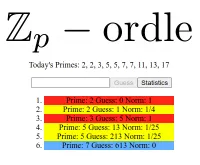
Zp-ordle is a fascinating number guessing game that combines math complexity with the thrill of prediction. Each day, you'll face a new challenge as a random number between 0 and 1000 is chosen. Your mission is to figure out that mysterious number using only 10 attempts, each connected to a prime number. What makes Zp-ordle truly unique is the use of p-adic distances, a captivating math concept that measures how close you are to the target number.
Zp-ordle takes number guessing games to a whole new level by incorporating p-adic distances. But what exactly are p-adic distances and how do they work in the game?
P-adic distances are a branch of math that measures the "closeness" of numbers in a unique way. Instead of the familiar Euclidean distance we use in everyday life, p-adic distances are determined by a prime number "p." In this game, since you have 10 attempts, each associated with a prime number, you'll be using these primes (2, 3, 5, 7, 11, 13, 17, 19, 23, and 29) to calculate how close your guess is to the target number.
Every day, a random number is selected. You have 10 guesses, each associated with a prime number in increasing order. The game reveals the p-adic distance between your guess and the target number based on the prime number you used.
When you make a guess, the game calculates the p-adic distance between your guess and the target number for each of the 10 prime numbers. The smaller the p-adic distance for a prime number, the closer your guess is to the actual number. Your score for that guess is the sum of these 10 distances. The goal is to minimize your score with each attempt, getting as close to the target number as possible. To add to the challenge, Zp-ordle introduces a time element. You have limited time to make each guess, and as the clock ticks down, the pressure builds.
Mathle is a word game that puts a math twist on Wordle. In this game, you'll be uncovering equations made up of numbers, addition and subtraction. The challenge lies in finding the correct equations to solve the puzzle.